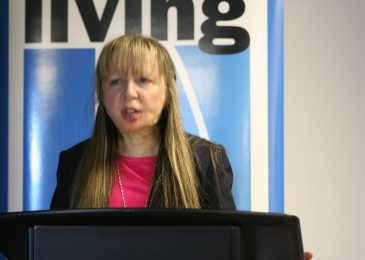Sherry Costa is the executive director of Independent Living Nova Scotia.
Among Canadians with a disability, 12% reported having been refused a job in the previous five years as a result of their condition. The percentage was 33% among 25 – 34 year olds with a severe or very severe disability, according to StatsCan.
People with disabilities are always a problem, never an asset.
Employing people with disabilities isn’t just an act of charity. It means independence for the employee, who can be among the most reliable and dedicated of workers. It breaks the all-too-frequent link between Government support and disability. It also makes good business sense.

Using a ballpark figure of $1000 per month as basic government support for housing, food and personal expenses, moving from dependence to work, or preventing dependence in the first place, can save taxpayers $12,000 per person per year. By way of comparison, it takes a $94,000 salary to generate $12,000 in Nova Scotia income tax. And the savings are not just for one year, but every year. Two years employment saves taxpayers $24,000 and ten years saves $120,000.
Access to Community Education & Employment, ACEE, is a program of Independent Living Nova Scotia, ILNS, designed to facilitate the transition from high school to self-reliance for young people with disabilities. The cost of ACEE is about $10,000 per enrollee. ACEE picks up where school leaves off, teaching students about managing money, self-care, job-seeking and practical skills not taught in high school.
We already have a stake in these young people. In 2008, the per pupil annual expenditure in Nova Scotia was just over $10,000. That means young people in ACEE represent a $120,000 investment even before they start the program.
Taking a pessimistic view – 12 students per year graduating to employment, $260,000 program cost, the picture would look like this 12 years on: taxpayers have invested $3,380,000 and saved $9,724,000 – a 388% return. Not bad, but the program has been unceremoniously defunded. The grant was a combination of funding from the provincial Department of Education and the provincial Department of Community Services, but administered by the Halifax Regional School.
On June 21, 2016 the government report From School to Success: Clearing the Path was released. It contains 15 detailed recommendations that relate to helping young Nova Scotians move successfully from school to post-secondary education, training and the workforce.
Here’s something from the Executive Summary:
In fall 2015, Education and Early Childhood Minister Karen Casey and Labour and Advanced Education Minister Kelly Regan appointed a task force to recommend ways to more effectively support all students as they transition from public school into college, university, apprenticeship and the workforce.
Curiously, ILNS, which actually has been working in this exact field for a dozen years, funded by the Department of Education itself, was not represented or consulted. ACEE is never mentioned in 51 pages, not even as a bad example. Nor was anyone from the spectrum of disability organizations on the panel. No one.
Like the OneNS report We Chose Now, Clearing the Path makes brief reference to people with disabilities, typically in the context of at-risk communities requiring additional support.
Programs for all learners, including African Nova Scotian, Mi’kmaw, youth with disabilities, and other under-represented communities must be a part of a cohesive, accessible system.
People with disabilities are always a problem, never an asset.
The thinking behind Clearing the Path is clear – we must provide well-trained and appropriate workers to business. This goes hand-in hand with Dalhousie’s move away from Art, emphasizing trades like engineering and business instead.
The real losers here are the 6% of students identified as having disabilities. They face a host of barriers, most unknown and unrecognized by people without disabilities. They require accommodations, they face open discrimination, they lack basic skills of daily use. The notion that career development for people with disabilities is analogous to vocational job placement is way too simplistic.
In sum, a long running program to enhance employability of people with disabilities, delivered by people with disabilities, given free rein by three arms of government for many years, probably saving taxpayers substantial sums is suddenly canceled in favor of a program designed by people, none of whom are people with disabilities and who confuse education with supply‐chain management.
People with disabilities need an explanation. More importantly, we need Independent Living Nova Scotia and the Access to Employment and Education program. We created it, we need it, it works, and it’s a symbol of self determination. Without it, too many will be left behind.
Support Independent Living Nova Scotia
See also: Cancelled transitionn program leaves youth with disabilities without options



